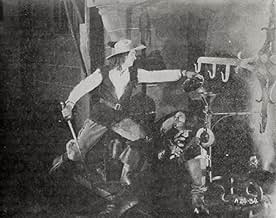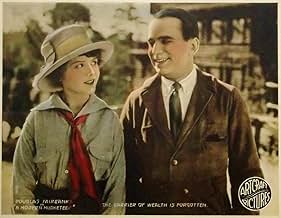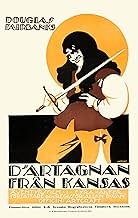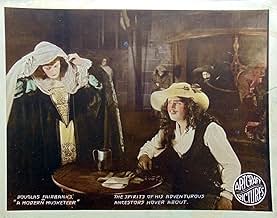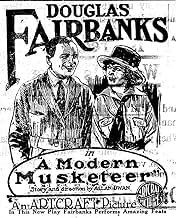Füge eine Handlung in deiner Sprache hinzuA restless young man travels west, encountering adventure, romance, and danger.A restless young man travels west, encountering adventure, romance, and danger.A restless young man travels west, encountering adventure, romance, and danger.
- Regie
- Drehbuch
- Hauptbesetzung
Empfohlene Bewertungen
'The Modern Musketeer', now complete and restored thanks to the efforts of the Danish Film Archive, is a fun modern adventure film starring the ever smiling Douglas Fairbanks (Snr). The first scenes show our hero as D'Artagnan of the Three Musketeers, swashing a buckle to rescue a young lady's handkerchief, before fast forwarding to modern times where Ned Thacker, his mother obsessed with the Dumas novel, has been brought up to be chivalrous (and rather irritating) where young ladies are concerned.
When Ned decides to leave for the big wide world in his new car - not until after he's climbed the church spire (as you do) - he meets Elsie Dodge, who's being railroaded into marriage with an unpleasant and cheating millionaire. Falling for Elsie he first lets her share his lunch hamper, then saves her from a fate worse than death at the hands of the local Injun (man with teeth necklace who thinks that makes him king).
Great action sequences involving ropes, jumps, and various acrobatics prefigure Fairbanks' later cinematic adventures. Marjorie Daw plays Elsie as the blushing young ingénue, while Tully Marshall pops up as a wronged man out for revenge. Although this film loses its way somewhat - starting as a likable comedy and then becoming a wild west adventure - it wears its years well and is worth a look.
When Ned decides to leave for the big wide world in his new car - not until after he's climbed the church spire (as you do) - he meets Elsie Dodge, who's being railroaded into marriage with an unpleasant and cheating millionaire. Falling for Elsie he first lets her share his lunch hamper, then saves her from a fate worse than death at the hands of the local Injun (man with teeth necklace who thinks that makes him king).
Great action sequences involving ropes, jumps, and various acrobatics prefigure Fairbanks' later cinematic adventures. Marjorie Daw plays Elsie as the blushing young ingénue, while Tully Marshall pops up as a wronged man out for revenge. Although this film loses its way somewhat - starting as a likable comedy and then becoming a wild west adventure - it wears its years well and is worth a look.
This will be one of the more enjoyable silent movies you'll come across - restored by the Danish Film Institute and of very good quality, and starring one of the greats of the silent era - Douglas Fairbanks, Sr. - as Ned Thacker, a man raised in Kansas being read the stories of D'Artagnan by his mother, and who grows up to be a modern day version of the musketeer, defending the honour of women at every step.
The movie opens with two really good fight scenes - a swashbuckling look back at D'Artagnan (also played by Fairbanks) as he fights to re-claim a woman's handkerchief, and our first look at Thatcher in a bar-room brawl as he defends the honour of a woman he thought was being treated poorly by her male companion. These were both fun scenes, and I enjoyed the unexpected humour as we got a glimpse of how Ned started his career as a chivalrous man by being arrested on a streetcar as he demands that a man give up his seat for two women, only to discover that the man was the chief of police! So the story had a good start.
If it lost its way a bit, it was in the decision to then focus exclusively on Ned's pursuit of Elsie Dodge (Marjorie Daw) - a young woman being forced by her mother into a relationship with a rich man in order to help pay bills. I thought the story might have been more effective if it had continued to be a series of vignettes of Thacker defending women in various circumstances. The move into the Grand Canyon, and the introduction of the bad Indian Chin-de-dah (Frank Campeau) - who fancies himself a king and decides he's going to kidnap and marry Elsie - struck me as an unnecessary diversion, which ended up as far more than a diversion - it becomes the story.
Still, if that goes a little too far, this was still a fun movie. There's no doubt about that. I enjoyed Fairbanks. Overall I thought both the movie and Fairbanks had the feel of something you might have seen remade by Bob Hope in the 1940's - a light, silly, Western-oriented comedy. A typical line, for example, that I could easily have seen put on Hope's mouth (which, of course, in this is simply a caption) comes as Ned and Elsie look at the splendour of the Grand Canyon and Ned says "Golly. A gully." That's the sort of light comedy I hear coming from Hope's mouth. This has a lot of that, and some good action scenes, and those opening fight scenes that really do draw you in. (7/10)
The movie opens with two really good fight scenes - a swashbuckling look back at D'Artagnan (also played by Fairbanks) as he fights to re-claim a woman's handkerchief, and our first look at Thatcher in a bar-room brawl as he defends the honour of a woman he thought was being treated poorly by her male companion. These were both fun scenes, and I enjoyed the unexpected humour as we got a glimpse of how Ned started his career as a chivalrous man by being arrested on a streetcar as he demands that a man give up his seat for two women, only to discover that the man was the chief of police! So the story had a good start.
If it lost its way a bit, it was in the decision to then focus exclusively on Ned's pursuit of Elsie Dodge (Marjorie Daw) - a young woman being forced by her mother into a relationship with a rich man in order to help pay bills. I thought the story might have been more effective if it had continued to be a series of vignettes of Thacker defending women in various circumstances. The move into the Grand Canyon, and the introduction of the bad Indian Chin-de-dah (Frank Campeau) - who fancies himself a king and decides he's going to kidnap and marry Elsie - struck me as an unnecessary diversion, which ended up as far more than a diversion - it becomes the story.
Still, if that goes a little too far, this was still a fun movie. There's no doubt about that. I enjoyed Fairbanks. Overall I thought both the movie and Fairbanks had the feel of something you might have seen remade by Bob Hope in the 1940's - a light, silly, Western-oriented comedy. A typical line, for example, that I could easily have seen put on Hope's mouth (which, of course, in this is simply a caption) comes as Ned and Elsie look at the splendour of the Grand Canyon and Ned says "Golly. A gully." That's the sort of light comedy I hear coming from Hope's mouth. This has a lot of that, and some good action scenes, and those opening fight scenes that really do draw you in. (7/10)
Modern Musketeer, The (1917)
*** (out of 4)
Fun silent film has Douglas Fairbanks playing a man living in Kansas with his parents who dreams of a more exciting life. Ever since he was a child his mother read to him The Three Musketeers so as an adult he grows tired of his town and heads out west in hopes of romance and adventure. Until recently the second half of this film was lost but it was eventually found and the film recently premiered on Turner Classic Movies. A lot of lost movies that get found are usually big letdowns but this film here actually is pretty good and should keep action fans entertained. The film opens up with a wild, ten minute sequence, which contains just about every type of action you can imagine. We have wild fist fights, broken glasses and various other items. The lively action at the start of the film makes the movie slow down a tad too much in the middle but the movie ends with more great action as Fairbanks must battle Indians. Fairbanks is very energetic in his role and makes a great character here. Another bonus is a terrific wind storm that happens at the start of the film and the special effects here of the city being blown down are very good for their time. Future director Victor Fleming worked as the cinematographer.
*** (out of 4)
Fun silent film has Douglas Fairbanks playing a man living in Kansas with his parents who dreams of a more exciting life. Ever since he was a child his mother read to him The Three Musketeers so as an adult he grows tired of his town and heads out west in hopes of romance and adventure. Until recently the second half of this film was lost but it was eventually found and the film recently premiered on Turner Classic Movies. A lot of lost movies that get found are usually big letdowns but this film here actually is pretty good and should keep action fans entertained. The film opens up with a wild, ten minute sequence, which contains just about every type of action you can imagine. We have wild fist fights, broken glasses and various other items. The lively action at the start of the film makes the movie slow down a tad too much in the middle but the movie ends with more great action as Fairbanks must battle Indians. Fairbanks is very energetic in his role and makes a great character here. Another bonus is a terrific wind storm that happens at the start of the film and the special effects here of the city being blown down are very good for their time. Future director Victor Fleming worked as the cinematographer.
Turner Classic Movies showed a complete print of "A Modern Musketeer" last night, March 20, 2008. The credit at the end identified the movie as a 2006 Danish Film Archive restoration. TCM added a Monte Alto Orchestra score to the silent. The Danish Archive did a mighty fine job restoring the movie, if the the print had any speckles, fading or snow, I missed seeing them. The miracles of a frame-by-frame computer restoration of a 90+ year old movie.
The movie itself is a showcase for Douglas Fairbanks' acrobatic talents. His playing a role set in the present does not stop him from doing a handstand at the edge of a precipice, getting onto a horse by leaping onto the saddle without using a stirrup (Steve McQueen did that too in his western TV series, but Fairbanks does the leap further from the saddle) and sliding in and out of cut stone windows at every opportunity.
This movie shows that in 1917 Hollywood art directors were on the ball. At the end, the movie's interior action takes place in a set that represents an Anasazi cave dwelling. This cave set sure looks authentic to me. The director Alan Dwan later said that in a Fairbanks movie everything was arranged to make it look as if Fairbanks was not exerting himself as he performed his stunts. So the height of windows in the cave set allow Fairbanks to fly though them. Outside of this set, much of the action seems to take place on the south rim of the Grand Canyon, not far from the El Tovar hotel.
If the El Tovar hotel gave the cast and crew of this movie free or discounted accommodations, I would not be surprised. At every chance, the movie uses vistas of the Grand Canyon as background for the action. The El Tovar hotel must have seen a spike in tourists staying at the hotel after the movie came out, moviegoers who became tourists.
The movie's story is pretty lame. Fairbanks rescues the girl from not one, but two villains. But the story is important only in that it showcases Fairbanks the personality and the stunt man. Thanks to the Danish film archive and TCM, this Fairbanks star vehicle is again available for viewing (when TCM shows it again). ---
Addition (26 July 2009): I finally bought on sale A Modern Musketeer on DVD as part of the Douglas Fairbanks 5 DVD movie box set of the same name. The one thing that stands out for me now is how advanced most of the movie image framing and editing is. For a 1917 movie, you expect and usually get interior scenes that are static with the camera too far from the actors, as if filming a stage play. Even in 1924's The Sea Hawk, the scenes inside the family manor were shot wide a lot, with few medium close-ups. Not in the case in A Modern Musketeer, where director Dwan keeps the camera much closer to the actors, even when the Grand Canyon is the backdrop, varying the shot selection a lot, just like in movies made decades later.
On the commentary track, the film experts mentioned how many scenes in the movie were shot at less than 24 frames per second, adding speed to the action. I did not notice that undercranking when I saw the movie now, but I did notice that Dwan used an awful lot of setups to film the action from different perspectives. One commentator mentioned how good the wide angle chase scene through the wide floor of the canyon (an area now probably flooded by Lake Meade) must have looked when the original, undamaged print was projected on the big screen in the Rivoli Theater in 1917, as first one group of riders, than a second, take off after Fairbanks and company on the run on horseback. Dwan took advantage of the majestic location to make this wide angle shot, which would look at home in a modern Western except for the missing inserts showing close up shots of the riders. But then, Dwan doesn't overdo the editing, no jump cuts for him either.
The commentators mentioned that other filmmakers copied some scenes in the movie, indicating one streetcar scene that Harold Lloyd used and a "cyclone" scene in Kansas with a house falling down that Buster Keaton referred to years later. I think that Dwan's style of editing and framing scenes must have been copied as well. What also stands out for me, though, is how Dwan, with the limited camera technology then available, moved the camera every which way with loads of setups to compensate for the lack of close-up lenses, no use then (as far as I know) of cameras on rails and managing to film those location scenes at the Grand Canyon using orthochromatic film (the last mostly the responsibility of ace cinematographer Hugh McClung).
The movie itself is a showcase for Douglas Fairbanks' acrobatic talents. His playing a role set in the present does not stop him from doing a handstand at the edge of a precipice, getting onto a horse by leaping onto the saddle without using a stirrup (Steve McQueen did that too in his western TV series, but Fairbanks does the leap further from the saddle) and sliding in and out of cut stone windows at every opportunity.
This movie shows that in 1917 Hollywood art directors were on the ball. At the end, the movie's interior action takes place in a set that represents an Anasazi cave dwelling. This cave set sure looks authentic to me. The director Alan Dwan later said that in a Fairbanks movie everything was arranged to make it look as if Fairbanks was not exerting himself as he performed his stunts. So the height of windows in the cave set allow Fairbanks to fly though them. Outside of this set, much of the action seems to take place on the south rim of the Grand Canyon, not far from the El Tovar hotel.
If the El Tovar hotel gave the cast and crew of this movie free or discounted accommodations, I would not be surprised. At every chance, the movie uses vistas of the Grand Canyon as background for the action. The El Tovar hotel must have seen a spike in tourists staying at the hotel after the movie came out, moviegoers who became tourists.
The movie's story is pretty lame. Fairbanks rescues the girl from not one, but two villains. But the story is important only in that it showcases Fairbanks the personality and the stunt man. Thanks to the Danish film archive and TCM, this Fairbanks star vehicle is again available for viewing (when TCM shows it again). ---
Addition (26 July 2009): I finally bought on sale A Modern Musketeer on DVD as part of the Douglas Fairbanks 5 DVD movie box set of the same name. The one thing that stands out for me now is how advanced most of the movie image framing and editing is. For a 1917 movie, you expect and usually get interior scenes that are static with the camera too far from the actors, as if filming a stage play. Even in 1924's The Sea Hawk, the scenes inside the family manor were shot wide a lot, with few medium close-ups. Not in the case in A Modern Musketeer, where director Dwan keeps the camera much closer to the actors, even when the Grand Canyon is the backdrop, varying the shot selection a lot, just like in movies made decades later.
On the commentary track, the film experts mentioned how many scenes in the movie were shot at less than 24 frames per second, adding speed to the action. I did not notice that undercranking when I saw the movie now, but I did notice that Dwan used an awful lot of setups to film the action from different perspectives. One commentator mentioned how good the wide angle chase scene through the wide floor of the canyon (an area now probably flooded by Lake Meade) must have looked when the original, undamaged print was projected on the big screen in the Rivoli Theater in 1917, as first one group of riders, than a second, take off after Fairbanks and company on the run on horseback. Dwan took advantage of the majestic location to make this wide angle shot, which would look at home in a modern Western except for the missing inserts showing close up shots of the riders. But then, Dwan doesn't overdo the editing, no jump cuts for him either.
The commentators mentioned that other filmmakers copied some scenes in the movie, indicating one streetcar scene that Harold Lloyd used and a "cyclone" scene in Kansas with a house falling down that Buster Keaton referred to years later. I think that Dwan's style of editing and framing scenes must have been copied as well. What also stands out for me, though, is how Dwan, with the limited camera technology then available, moved the camera every which way with loads of setups to compensate for the lack of close-up lenses, no use then (as far as I know) of cameras on rails and managing to film those location scenes at the Grand Canyon using orthochromatic film (the last mostly the responsibility of ace cinematographer Hugh McClung).
Boyish adventurer Douglas Fairbanks (as Ned Thacker) imagines himself as an Alexandre Dumas-like "D'Artagnan of Kansas", but local town-folk aren't taken by his chivalrous "Three Musketeers" routine. On the road seeking greener pastures, Mr. Fairbanks meets sweet young Marjorie Daw (as Elsie Dodge). She is promised, however, to middle-aged millionaire Eugene Ormonde (as Forrest Vandeteer). Their love story takes a back seat to Fairbanks' athletic antics, with trusty Tully Marshall (as James Brown) providing his usual good support.
Tully comes in handy when Navajo nasty Frank Campeau (as Chin-de-dah) goes out looking for a "white woman" for sex - of course, she's also Fairbanks' choice for a mate. A Native American Indian, Mr. Campeau greets Fairbanks by saying "How," and ends up with egg on his face. The cast and crew stay at the El Tovar Hotel, with the backdrop of Arizona's "Grand Canyon" providing an exciting location for Fairbanks and company. "A Modern Musketeer" was missing a couple of reels until recently. Now, a full-length restoration is available.
***** A Modern Musketeer (12/30/17) Allan Dwan ~ Douglas Fairbanks, Marjorie Daw, Tully Marshall, Frank Campeau
Tully comes in handy when Navajo nasty Frank Campeau (as Chin-de-dah) goes out looking for a "white woman" for sex - of course, she's also Fairbanks' choice for a mate. A Native American Indian, Mr. Campeau greets Fairbanks by saying "How," and ends up with egg on his face. The cast and crew stay at the El Tovar Hotel, with the backdrop of Arizona's "Grand Canyon" providing an exciting location for Fairbanks and company. "A Modern Musketeer" was missing a couple of reels until recently. Now, a full-length restoration is available.
***** A Modern Musketeer (12/30/17) Allan Dwan ~ Douglas Fairbanks, Marjorie Daw, Tully Marshall, Frank Campeau
Wusstest du schon
- WissenswertesMarjorie Daw and Kathleen Kirkham, daughter and mother, were seven years apart in age. Daw was only 15(!) when this film was made, which means that she was closer in age to the actress playing her mother than she was to the actor playing her leading man (Douglas Fairbanks was 18 years her senior).
- PatzerWhen Chin-de-dah leads Vandeteer and Elsie through the Canyon, the shadows of the cameraman and another crew member are visible on the ground.
- Crazy CreditsExcept for Douglas Fairbanks, whose name appears above the title, there is no cast list. Actors are introduced by intertitle cards just before they appear on the screen. The IMDb cast list therefore uses this "order of appearance" sequence.
- Alternative VersionenIn 2006, the Danish Film Institute copyrighted a 68-minute version of this film, with a musical score played by the Mont Alto Orchestra. Additional restoration and music credits stretch the time to 69 minutes.
- VerbindungenReferenced in Chaplin - Das Leben der unsterblichen Filmlegende (1992)
Top-Auswahl
Melde dich zum Bewerten an und greife auf die Watchlist für personalisierte Empfehlungen zu.
Details
- Laufzeit
- 1 Std. 8 Min.(68 min)
- Sound-Mix
- Seitenverhältnis
- 1.33 : 1
Zu dieser Seite beitragen
Bearbeitung vorschlagen oder fehlenden Inhalt hinzufügen

